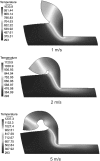Generation of segmental chips in metal cutting modeled with the PFEM
- PMID: 31007328
- PMCID: PMC6445558
- DOI: 10.1007/s00466-017-1442-z
Generation of segmental chips in metal cutting modeled with the PFEM
Abstract
The Particle Finite Element Method, a lagrangian finite element method based on a continuous Delaunay re-triangulation of the domain, is used to study machining of Ti6Al4V. In this work the method is revised and applied to study the influence of the cutting speed on the cutting force and the chip formation process. A parametric methodology for the detection and treatment of the rigid tool contact is presented. The adaptive insertion and removal of particles are developed and employed in order to sidestep the difficulties associated with mesh distortion, shear localization as well as for resolving the fine-scale features of the solution. The performance of PFEM is studied with a set of different two-dimensional orthogonal cutting tests. It is shown that, despite its Lagrangian nature, the proposed combined finite element-particle method is well suited for large deformation metal cutting problems with continuous chip and serrated chip formation.
Keywords: Metal cutting processes; Particle Finite Element Method (PFEM); Serrated chip formation.
Figures













References
-
- Bäker M. Finite element simulation of high-speed cutting forces. J Mater Process Technol. 2006;176:117–126. doi: 10.1016/j.jmatprotec.2006.02.019. - DOI
-
- Belytschko T, Liu WK, Moran B. Nonlinear finite element for continua and structures. New York: Wiley; 2000.
-
- Bonet J, Wood RD. Nonlinear continuum mechanics for finite element analysis. Cambridge: Cambridge University Press; 1997.
-
- Cante J, Dávalos C, Hernández JA, Oliver J, Jonsén P, Gustafsson G, Häggblad HÄ. PFEM-based modeling of industrial granular flows. Computat Part Mech. 2014;1:47–70. doi: 10.1007/s40571-014-0004-9. - DOI
-
- Carbonell JM (2009) Modeling of ground excavation with the particle finite element method. Ph.D. thesis, Universitat Politècnica de Catalunya (UPC), Barcelona
LinkOut - more resources
Full Text Sources
